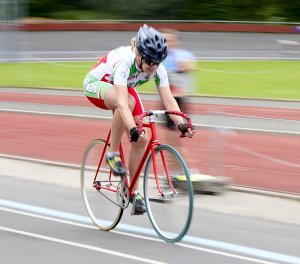|
Advice on getting involved in other clubs'
track races
 As the title implies, track racing takes place on tracks,
or velodromes as they are sometimes called. There are many
similarities to athletics, with events taking place on purpose-built
tracks, usually 400 metres (440 yards) around, although the
size can vary. Races range from sprints of 400 to 1000 metres,
through middle distance of two miles to five, right up to
events of an hour or more in duration. World-class riders
compete in team races that last for six days.
As the title implies, track racing takes place on tracks,
or velodromes as they are sometimes called. There are many
similarities to athletics, with events taking place on purpose-built
tracks, usually 400 metres (440 yards) around, although the
size can vary. Races range from sprints of 400 to 1000 metres,
through middle distance of two miles to five, right up to
events of an hour or more in duration. World-class riders
compete in team races that last for six days.
First, talk to your club
coach, so that you will know the rules that apply to the
various events and the safety protocols that must be observed
when entering and riding on the track. Then go to the track
and put some time in riding laps in the company of an experienced
rider or coach. Beacon does not have its own track, but hires
a local one whenever there is sufficient demand. The club's
Track Secretary can
give you more details. Track bikes take a little getting used
to, but you should be reasonably competent after an hour or
so's practice.
For the beginner, the place to learn your craft is a local
track league. These take place at Halesowen
on a Friday evening, and Wolverhampton
on a Wednesday evening. Once you have paid the registration
fee, you just turn up and pay to ride on the evening you want
to race.
Here the similarity to athletics ends. Whereas a runner competes
in one, maybe two events, the cycling trackie will try to
get into nearly every race on the programme. You can expect
to ride in four events at least in the course of a couple
of hours. Track leagues cater for all classes, from juveniles
to those of sixty years plus. Girls and women can have their
own events or mix it with the boys or men.
When you feel confident, you can enter open events. These
normally take place on a Saturday or Sunday, and usually involve
travelling. Information regarding locations, closing dates
for entering, etc. can be obtained from the
BC website, or handbook, which you can get hold of through
the club Track Secretary.
The equipment for track racing is delightfully simple. A
crash helmet, then a frame with saddle, handlebars, transmission
(chain set and chain) and wheels fitted with the lightest
tyres you can afford. No gears, no brakes, no mudguards or
bottle cages. If this worries you, be reassured that track
racing is the safest form of cycling competition. No traffic,
no potholes, no fallen trees, branches or broken glass. Everybody
is going in the same direction and because no one has any
brakes there are no sudden stops. Control is maintained by
all riders being on fixed cogs (you can't freewheel) and using
the track banking to slow down or accelerate. If you should
suffer a puncture or fatigue, the changing rooms and refreshments
are just beside the track.
Aside from buying the bike, the costs are as follows. You
must join British Cycling, the national governing body, which
will set you back between £12 and £32 depending on the type
of membership you want; then you need a racing licence, which
costs £30. The club Track Secretary will help you sort things
out. To join a track league costs £10, and then it's £2 to
£3 for every meeting in which you compete. These costs are
greatly reduced for people who are less than eighteen years
of age.
The outdoor season lasts from Easter to late September, and
for those so inclined, they can race indoors at Manchester
or Newport near Cardiff during the winter.
For a totally informal experience you can enter the Beacon
club track championships
that take place on a Sunday in late summer. Britain is a world
leader in this sport, so be ready for Olympic fame and fortune.
The club coach will tell you how to prepare for stardom.
|